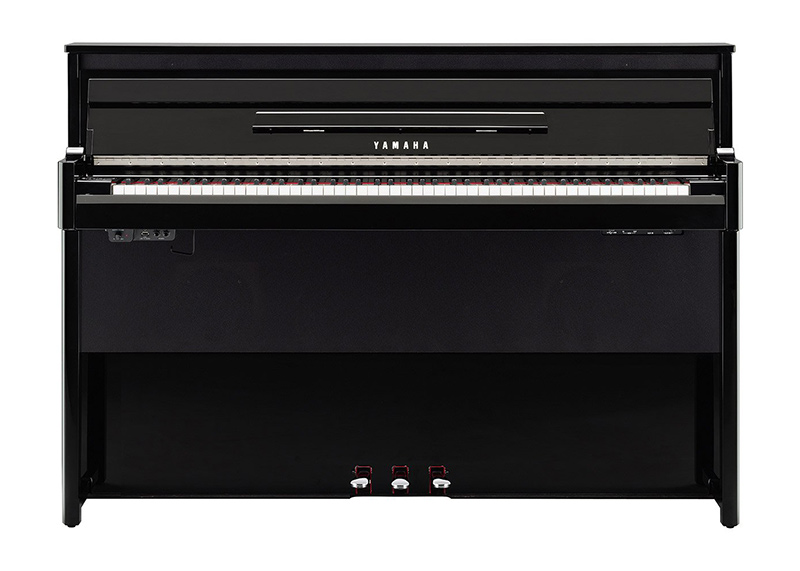
I hear a lot of talk about hybrid pianos being the next new thing and yet I believe there’s some confusion as to what a hybrid piano actually is and whether or not it can be used as a piano alternative in serious education. When we see hybrid cars driving about, from what we’ve seen in the media, it refers to an alternate power source providing some advantage in energy. While there are several kinds of hybrid vehicles, we generally assume hybrid as a gas/electric combination to power the vehicle. When it comes to pianos, hybrids refer to a digital piano combined with a traditional acoustic piano. But what is the driving force to manufacture a hybrid piano? What is the apparent advantage? What is the reasoning to make something both acoustic and electronic? Pianos are heavy, weighing in at hundreds of pounds (sometimes eclipsing 1000lbs!) They also require constant maintenance to stay in tune. But if you remove the strings and hammers, you could do away with the enormously heavy cast iron frame but then have no sound. Rather than strings and hammers, why not make the tone digital? You would have a light-weight piano with a traditional playing action. Several months ago we posted an article called
“Why upgrade from a digital piano?” in part because the action of a digital piano is vastly different from a conventional piano. But what happens if the action stays the same? What happens if you utilize a traditional piano action? In short, the hybrid piano sound comes from a digital recording while the feel of the keys is from a “real” piano. This has become today’s hybrid ~ digital piano, real touch. The question then is, does this provide a viable option for piano practice, performance and enjoyment?
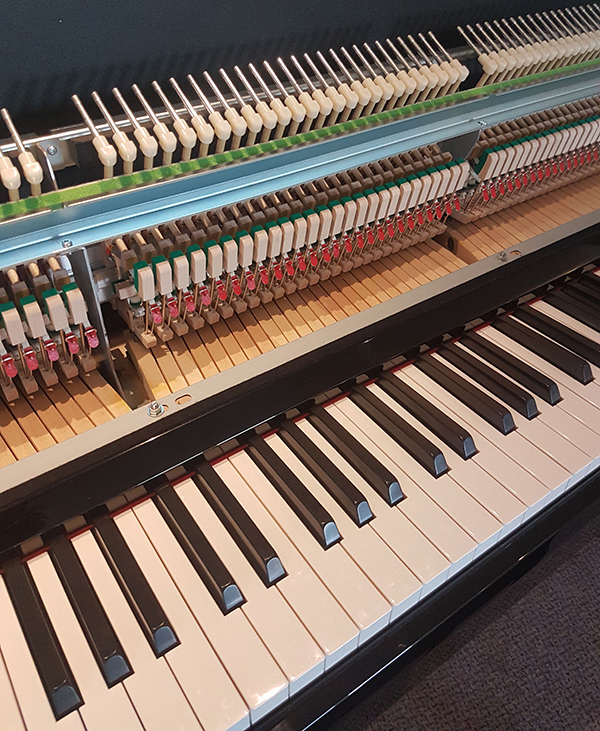 I recently had the opportunity to compare the Yamaha’s Avant hybrid series with Yamaha acoustic pianos. Armed with my digital gram scale and ruler, I thought it would be interesting to see the resemblances and differences between traditional piano actions and hybrid piano actions. When you first “look under the hood” at the hybrid pianos, I was surprised to see that they look identical to a real piano. The only change was the hammer head. On an acoustic piano, the part that strikes the strings is a felt hammer head. Not having any strings in a hybrid, they have simply swapped out the hammer for a different “hammer” (as seen in the picture). Why have a hammer head at all? The hammers don’t strike anything in the hybrid. In fact, the notes you play on the keyboard and associated dynamic levels are accurately measured by infrared sensors under the keys. But the hammer shape present has to do with the weight of the keys. Pianos have a certain amount of touch weight so that when we depress a key, we feel comfortable resistance. The hammer head in a piano is part of the equation of touch. Remove that hammer and all of sudden, the touch no longer resembles that of a piano. Being a curious sort, I decided to unscrew several notes across the piano and weigh the hybrid hammers and was pleased to find out that they have emulated the weight of a real piano accurately. The model I chose to examine was the NU1X upright hybrid. Honestly, the “U1” in the middle of the NU1X model name is a bit misleading. It sounds like the counterpart is the popular Yamaha U1 but truly its closest neighbour in the acoustic piano action seems to be Yamaha’s b2. Length of key and the balance rail seemed to be identical. The action parts, the same size and hammer weight are almost identical. The hybrid piano action is truly a real piano action made out of wood, felt, leather and metal just the same as the acoustic pianos. In fact, you regulate (adjust) the action parts the same way. I then moved to the N3X grand piano. Again, I was amazed at how accurately the parts are in accordance with Yamaha’s traditional grand piano actions. The touch and response was smooth and accurate.
I recently had the opportunity to compare the Yamaha’s Avant hybrid series with Yamaha acoustic pianos. Armed with my digital gram scale and ruler, I thought it would be interesting to see the resemblances and differences between traditional piano actions and hybrid piano actions. When you first “look under the hood” at the hybrid pianos, I was surprised to see that they look identical to a real piano. The only change was the hammer head. On an acoustic piano, the part that strikes the strings is a felt hammer head. Not having any strings in a hybrid, they have simply swapped out the hammer for a different “hammer” (as seen in the picture). Why have a hammer head at all? The hammers don’t strike anything in the hybrid. In fact, the notes you play on the keyboard and associated dynamic levels are accurately measured by infrared sensors under the keys. But the hammer shape present has to do with the weight of the keys. Pianos have a certain amount of touch weight so that when we depress a key, we feel comfortable resistance. The hammer head in a piano is part of the equation of touch. Remove that hammer and all of sudden, the touch no longer resembles that of a piano. Being a curious sort, I decided to unscrew several notes across the piano and weigh the hybrid hammers and was pleased to find out that they have emulated the weight of a real piano accurately. The model I chose to examine was the NU1X upright hybrid. Honestly, the “U1” in the middle of the NU1X model name is a bit misleading. It sounds like the counterpart is the popular Yamaha U1 but truly its closest neighbour in the acoustic piano action seems to be Yamaha’s b2. Length of key and the balance rail seemed to be identical. The action parts, the same size and hammer weight are almost identical. The hybrid piano action is truly a real piano action made out of wood, felt, leather and metal just the same as the acoustic pianos. In fact, you regulate (adjust) the action parts the same way. I then moved to the N3X grand piano. Again, I was amazed at how accurately the parts are in accordance with Yamaha’s traditional grand piano actions. The touch and response was smooth and accurate.
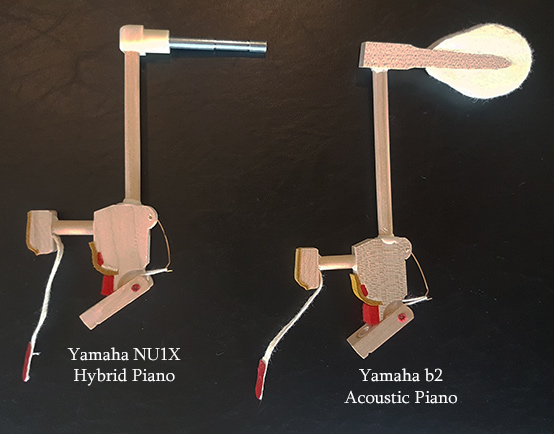 How I Compared Traditional Pianos with Hybrid Pianos
How I Compared Traditional Pianos with Hybrid Pianos
Our ears can play tricks on us. When you encounter an acoustic piano that is bright and brassy or one where the volume is too much for our ears, we accommodate by changing the way we play. Subconsciously, we think then that the piano action is light because we don’t press into the keys for fear of being overcome with percussive sound or extreme volume. We tend to think that the piano has a light touch and is easy to play. Conversely, if the sound of a piano is mellow and warm or it’s a quiet piano, we often press more into the keys and believe that the action is heavier. Physically nothing has changed but if you change the voice of the piano, you somehow think that the touch has also been altered. I often say “You play to the piano” – you accommodate your playing style to meet the needs of what our ears hear.
Ideally it would be advantageous to evaluate piano actions sans sound. One could then concentrate on precisely the feeling of the piano rather than be swayed by what tone is presented. On the hybrid piano, I simply turned off the power. Problem solved. In order to evaluate without my ears “tricking me”, I also found an acoustic piano with a silent feature which blocks the hammers from striking the strings. I could then play both the traditional piano and the hybrid without sound.
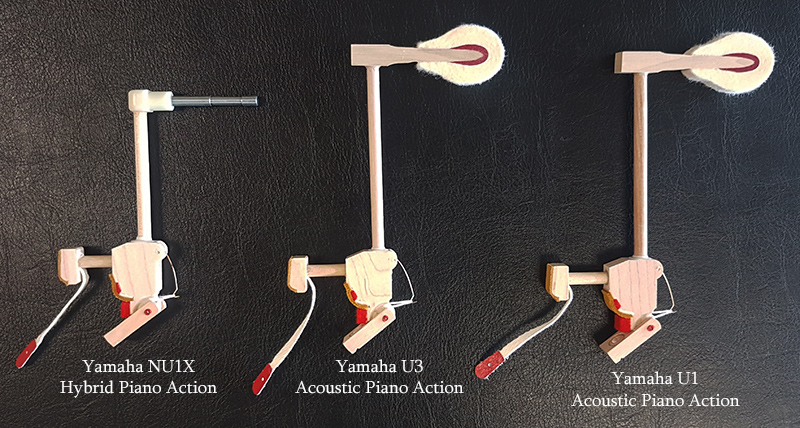 Side by side to a hybrid piano with the volume off, I was then able to compare apples with apples. I was playing a traditional piano with no sound and a hybrid piano with the volume off. While playing the piano without sound isn’t that exciting, it gave me the opportunity to evaluate the touch more closely. It was then that I realized that the action on the silent acoustic piano was part of the professional U series upright pianos. Compared to the b series, the touch was significantly different. In a nutshell, the U series has a much larger piano action and longer keys than the b series. This makes for a substantial feel and control difference while playing. (See also our article entitled “Why Upgrade to a Professional Level Piano?”) That said, both pianos are silky smooth and wonderful to play. I do feel, however that if you’re thinking of a hybrid for the purposes of practice, the hybrid upright piano actions are inadequate for advanced playing. It is at that point, one should consider the benefits of the grand action in the Avant series.
Side by side to a hybrid piano with the volume off, I was then able to compare apples with apples. I was playing a traditional piano with no sound and a hybrid piano with the volume off. While playing the piano without sound isn’t that exciting, it gave me the opportunity to evaluate the touch more closely. It was then that I realized that the action on the silent acoustic piano was part of the professional U series upright pianos. Compared to the b series, the touch was significantly different. In a nutshell, the U series has a much larger piano action and longer keys than the b series. This makes for a substantial feel and control difference while playing. (See also our article entitled “Why Upgrade to a Professional Level Piano?”) That said, both pianos are silky smooth and wonderful to play. I do feel, however that if you’re thinking of a hybrid for the purposes of practice, the hybrid upright piano actions are inadequate for advanced playing. It is at that point, one should consider the benefits of the grand action in the Avant series.
Evaluation of Tone
There is no question that the hybrid pianos from Yamaha sound fabulous. I took some time comparing Yamaha’s Clavinova series to the Avant hybrid series. The hybrids are truly king of the digital world. But how do they stack up against traditional pianos? Can they be used as a replacement? Many have often stated “I just can’t play a digital piano because you can’t feel the vibration of the strings”. Yamaha has thought about this and actually even emulated string vibration under your fingers! But how does it actually sound? Again I spent hours going back and forth between acoustic uprights, grands and hybrid pianos. The sound of the recording inside the hybrid is impeccably captured. The ‘sample’ is the recording of the real piano they use inside both digital and hybrid piano. Yamaha’s samples are believable, presenting matched tone with appropriate touch on the keys. Going from ppp to fff the tone transitions from felty and soft to bold and strident like a real piano. Often I hear digital pianos sound with a sample that’s good for one dynamic range and the volume is turned up or down depending on how hard you play. But that isn’t how traditional pianos work. Hammers have more or less force applied and compression of felt the harder you play which creates not only a volume difference but also a tonal change. Yamaha has captured this in the Avant series. But wait, there’s more! On the new NU1X, Yamaha has even made a type of resonating cabinet for even an even closer sound-matching experience to acoustic pianos by inserting sound baffles and acoustic tubes on the back of the piano.
Final Words
I was debriefing this experience with a friend of mine because I couldn’t put my finger on the fact that there was still something lacking, something amiss when I played the hybrid pianos. I found myself having difficulty connecting. And it’s not from the fact that I’m a Luddite, stuck in the mud of tradition. I feel that I’m open-minded to a new way of thinking so long as it meets the mechanical and more importantly, musical requirements I so desire. And so I put these hybrids to the test. I weighed the keys, the action parts, the hammers. I evaluated the tone judiciously, but in the end found that I was somehow slightly removed on hybrids than traditional pianos. My friend then gave the example which rings true with me. He said “Glen, you’ve used apps like Face Time or Skype where you can see your Mom on the other side of the country. Yes, you can perceive her expressions and hear her voice but there’s an electronic disconnect. We don’t gain the emotional nurture that we have in person. There is love and warmth face to face that you cannot replicate in electronics. There are other advantages like the fact that you can see your Mom frequently on Skype but nothing beats sitting down over coffee together.”
And I think that hit the nail on the head for me. I appreciate all of the aspects of technology. I fully endorse the actions and extreme detail Yamaha has gone to in replicating exacting touch so much so that you could use it to practice on. The tone has been emulated precisely and they are wonderful to play. In the end, if you don’t have the restrictions of volume control, portability or climate challenges, traditional pianos are still in my mind the way to go. Acoustic resonance of string vibration cannot be beaten. It’s the real McCoy. The hybrids, however weigh in very high for me and present just a short leap to acoustic playing. Kudos to Yamaha in pioneering this advancement, bridging the gap between digital pianos and acoustic instruments.
MORE PIANO ARTICLES
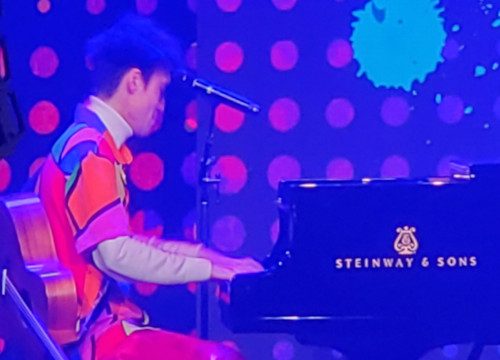
During the performance of Jacob Collier at the most recent NAMM show I was reminded that music makes us human, that beauty binds us together as a collective, and that the reason the music industry exists is to aid in the creation of art. I needed that reminder without which, the annual trade show featuring many of the great piano makers is just the sale of wares. I believe that people are feeling the uncertainty ...
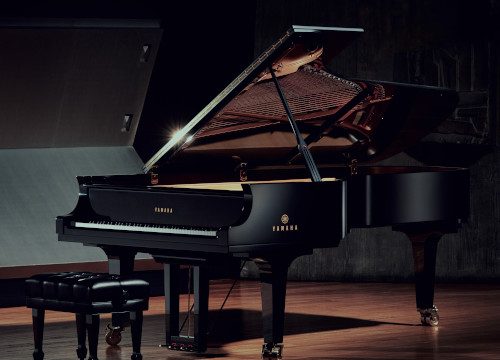
I used to have a teacher who would frequently say, “For every single grade point PAST 80%, it takes as much effort as the FIRST 80.” I believe this statement to be true from experience. The first 80 is the easiest. Chipping away at every point past that is the challenge. The bulk of the work can bring a project into shape but it’s the pursuit of excellence, that’s where the challenge lies. Yamaha is ...

The value of a piano is obvious ~ it’s the music that you make with it. But often, families are going through life changes which involve a house move and unfortunately, the piano needs to be sold. They invariably ask the question, “What are we going to do about the piano?” This question comes up because, as you can imagine, they’re not easy to move. We don’t simply pack them away in a cardboard box ...

You’ve been playing your piano for years now and the time has come to seriously consider downsizing the house and move into a condo. But what do you do with the piano? You love your piano and can’t imagine life without it and besides, you absolutely hate the idea of playing a digital keyboard. Many people don’t know that you can add digital functionality without compromising your existing piano. Yes, it is completely possible to ...
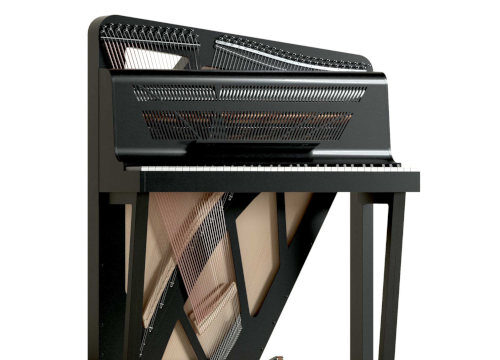
Many years ago, I remember seeing a piano in a museum similar to the one shown above (built in 1787 by Christian Gottlob Hubert. On display at Germanisches Nationalmuseum - Nuremberg, Germany). I have often wondered why acoustic portable pianos never really took off. Although we've seen more portable keyboard instruments like harpsichords, accordions or electronic keyboards, they operate completely different from a traditional piano in that they either pluck the strings, use air with ...
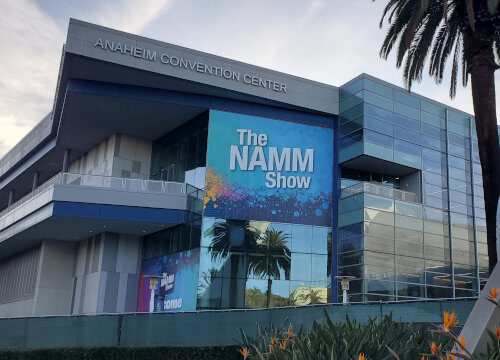
This was the first year since covid that the National Association of Music Merchants (NAMM) trade show was back to its regular January date and, in fact the first show where it felt back to normal. How was it? To answer that, I'm going quickly review the piano market over the last few years. Piano sales boomed during covid. Think about it - everyone was at home and with time on their hands, many turned ...